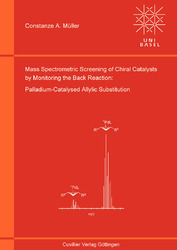| Departments | |
|---|---|
| Book Series (96) |
1378
|
| Nachhaltigkeit |
3
|
| Gesundheitswesen |
1
|
| Humanities |
2363
|
| Natural Sciences |
5406
|
| Mathematics | 229 |
| Informatics | 319 |
| Physics | 980 |
| Chemistry | 1363 |
| Geosciences | 131 |
| Human medicine | 243 |
| Stomatology | 10 |
| Veterinary medicine | 108 |
| Pharmacy | 147 |
| Biology | 835 |
| Biochemistry, molecular biology, gene technology | 121 |
| Biophysics | 25 |
| Domestic and nutritional science | 45 |
| Agricultural science | 1004 |
| Forest science | 201 |
| Horticultural science | 20 |
| Environmental research, ecology and landscape conservation | 148 |
| Engineering |
1791
|
| Common |
98
|
|
Leitlinien Unfallchirurgie
5. Auflage bestellen |
|
Advanced Search
Mass Spectrometric Screening of Chiral Catalysts (English shop)
Constanze Müller (Author)Preview
Table of Contents, Datei (33 KB)
Extract, Datei (100 KB)
The principle of microscopic reversibility serves as the basis of a novel screening method for the evaluation of chiral catalysts within asymmetric allylic substitution reactions. Monitoring the back reaction of quasienantiomeric products by electrospray ionisation mass spectrometry (ESI-MS) reveals the intrinsic enantioselectivity of palladium catalysts in the nucleophilic addition step and thus in the overall substitution process. As only the intrinsic selectivity is measured in the screening the effects of unselective background reaction, catalytically active
impurities and ligand dissociation do not alter the results, in contrast to product analysis.
The method was successfully applied to both linear diaryl and carbocyclic substrates.
Furthermore, a protocol for the simultaneous screening of catalyst mixtures was developed, offering new possibilities for high-throughput catalyst analysis.
| ISBN-13 (Printausgabe) | 3867276145 |
| ISBN-13 (Hard Copy) | 9783867276146 |
| ISBN-13 (eBook) | 9783736926141 |
| Final Book Format | A5 |
| Language | English |
| Page Number | 288 |
| Edition | 1 Aufl. |
| Volume | 0 |
| Publication Place | Göttingen |
| Place of Dissertation | Basel |
| Publication Date | 2008-06-09 |
| General Categorization | Dissertation |
| Departments |
Chemistry
|
| Keywords | Catalyst screening, electrospray ionisation mass spectrometry, asymmetric catalysis, allylic substitution, palladium. |








